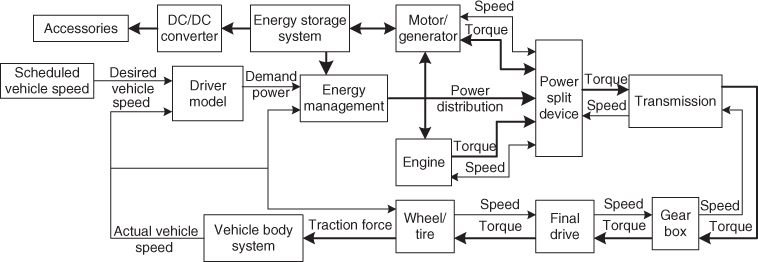Chapter 9: Hybrid Vehicle Design and Performance Analysis
Modeling and simulation have been widely used in hybrid electric vehicle design and performance analysis. Such simulation systems can be used to undertake various studies and assessments under given driving conditions. This chapter introduces the hybrid vehicle simulation system, typical driving cycles, and the sizing of the main system components based on the models presented in Chapter 3.
9.1 Hybrid vehicle simulation system
A hybrid vehicle simulation system can be simple or complicated depending on the requirements and objectives, but the basic system must consist of the engine, generator/motor set, power split device, transmission, DC–DC converter, gear box, final drive, wheel/tire, vehicle, and driver. An example of a hybrid vehicle simulation system is shown Fig. 9.1.
Figure 9.1 Basic hybrid electric vehicle simulation system.

In this simulation system, the driver model outputs the vehicle demand power to the energy management based on the difference between the desired vehicle speed and the actual vehicle speed. The energy management determines the required power from the engine and motor/generator, respectively. The power split device implements the power distribution to the engine and motor/generator and sets the corresponding speeds. The transmission model calculates the torque and speed at the output shaft. The ...
Get Introduction to Hybrid Vehicle System Modeling and Control now with the O’Reilly learning platform.
O’Reilly members experience books, live events, courses curated by job role, and more from O’Reilly and nearly 200 top publishers.

